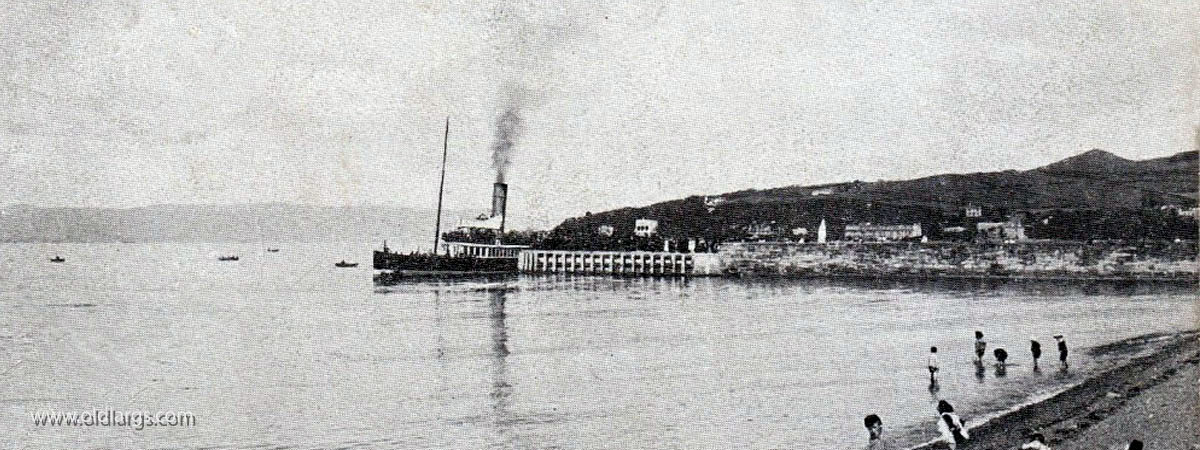
Visitors to Largs. 1822 to 1900
In this feature we will have a look at the ships which were regular visitors to Largs between the years 1822 and 1900.We have attempted to list as many vessels as possible which had links to Largs. This list is by no ways complete and to get a better understanding of the history of Clyde steamers we would like to point you to the many excellent books that have been published over the years. As such we have not included details of the vessels size, passenger capacity, or engine details as we just want to concentrate on providing information on the vessels link to largs, along with a brief history of the vessel and a few images.
For further reading we would recommend Andrew Clarks excellent book called "Pleasures of the Firth: Two Hundred Years of the Clyde Steamers 1812 - 2012" Recommended on line resources are the Scottish Built Ships web site , the Paddle Steamer Info Site and The Ships of CalMac site.PS Glasgow
1913 Built by John Wood Port GlasgowOne of the very first Clyde Wooden steamers, built only a year after the PS Comet which started the Clyde steamship era. Was placed on the Glasgow to Largs trade route. The Glasgow was the first ship to use the new Largs pier when it opened in in 1834.
PS Albion
1815 Built by John Wood Port GlasgowThe Albion was well known on the Glasgow to Largs route. She was famous for her lack of speed which she sadly lacked. Her lack of speed was nearly her downfall. On one occasion she ran over the piles in Largs Harbour because of a shortage of power. The accident ripped out her bottom and she sank on the spot. Her captain got some local friends to re float her and she sailed back to Greenock for repair. The Albion sailed up to 1834 when she was replaced by another of the same name. The replacement ship was built in 1834 and ran the Glasgow to Arran route calling in at Largs and Millport.
PS Largs
Built 1822 by John Wood of Port Glasgow Owned by J Kay.She plied the route from Glasgow to Largs and Millport. She was known to be in service in 1828 but must have been scrapped some time before she was replaced by another of the same name in the 1830s.
PS Largs II
Built 1864 by T Wingate & Co. Built for the Wemyss Bay Company.Started on the Broomielaw to largs and Millport run. Later she was switched to the Largs, Millport, Wemyss Bay, Rothesay and Kyles route. She ended up sailing under the Gillies and Campbell from Largs until 1977 when she was sold to English owners where she sailed for many years as the Mermaid.
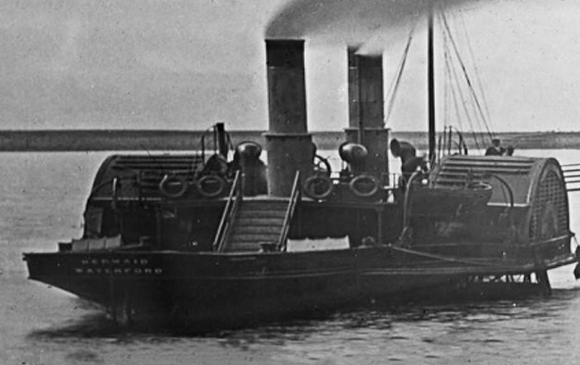
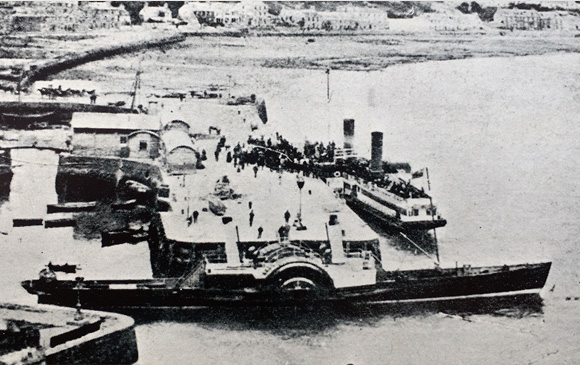
PS Largs
PS Largs at an unknown pier
PS Nimrod
Built 1834 by John Wood Port Glasgow. Owned by Currie and James Clark and was on the Largs to Ayr via Millport run.PS Victor
Built 1836 by Hunter & Dow.A name coming to the fore in the Largs are 1830s was that of Duncan Mckellar. who had a virtual monopoly on the Glasgow to Largs and Millport trade routes from the 1830s to the 1860s. Former soldier McKellar was a veteran of Waterloo and named many of his ships in recognition of his wartime exploits. The victor was a wooden steamer typical of its day which he used to build up his business It is thought he maintained a ferry service between largs and Cumbrae for over 10 years.
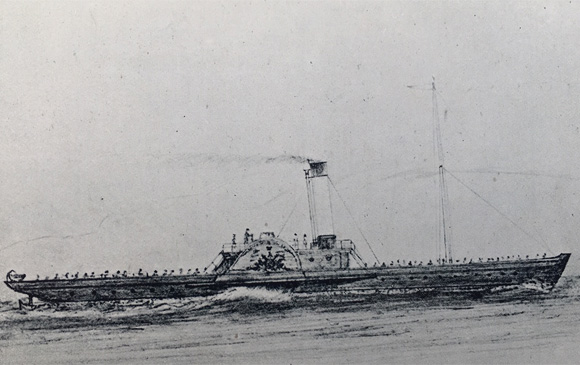
PS Ayrshire Lassie
1939 Built by Robert Duncan, GreenockWooden steamer owned by William Youngw and was stationed at Ayr for serving Largs and Millport 24/9/1839 made successful feasibility voyage Ardrossan to Belfast and in 1841 was running the Ayr-Stranraer and Ardrossan-Belfast passenger services. Moved to England and broken up in 1858.
PS Warrior
Built in 1839 Owned by Duncan McKellarWood Paddle Steamer. In 1839 serviced the runs from Glasgow to Ayr and to Greenock, Largs, Millport, Ardrossan and Arran. By 1853 she had her engine removed and converted to sailing vessel. By 1854 ended up in the West Indies via a spell in Portugal.
PS Lady Brisbane
Iron Paddle Steamer Built 1842. Owners Matthew PerstonThe arrival in 1842 of the Iron steamer Lady Brisbane and her sister ship Lady Kelburne raised standards by making it possible for the first time to travel from Glasgow to Largs and back in the same day. Ran the Millport to Largs and Glasgow route until 1864 when she sank off Bowling after a collision with the tug Flying Cloud. She was raised and repaired. Ended up on the Glasgow to Helensburgh run however in 1891 her engine collapsed when racing down the Gareloch and could not be repaired. She eventually saw fifty years of service and was scrapped in 1891 after the engine collapsed.
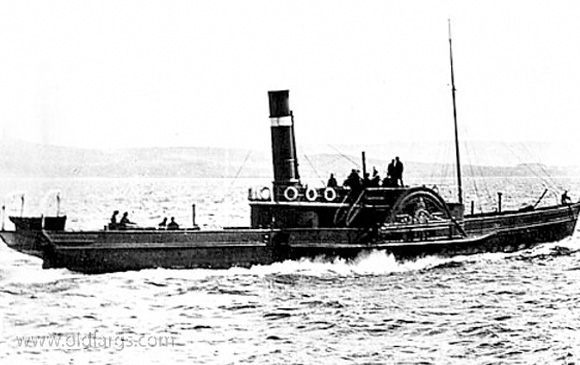
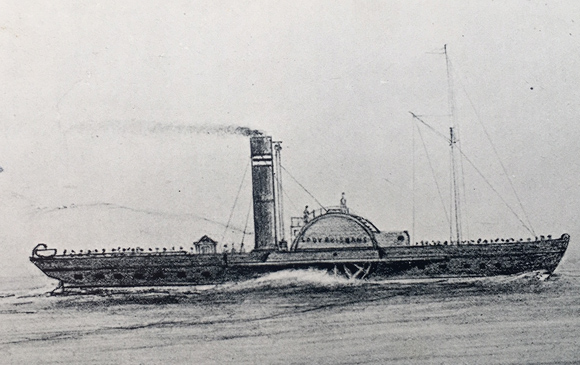
PS Lady Brisbane
PS Apollo
Built 1832 by Hunter & Dow GlasgowOperated on the Glasgow to largs, Millport and Ayr route for two years under the command of Stewart Boyd before being sold to London owners. She sank after a collison in 1837 with the drowning one of her stewardess and two children.
PS Mars
Built 1844 by Barr & McNab of PaisleyWith its fall funnel and its fast clipper lines the iron built Mars was regarded as a beauty. She was owned by A McKellar and ran the Largs to Millport route. Mars was one of the steamers which escorted the Royal Yacht when Queen Victoria visited the Clyde. Sadly she met her end after going aground at the mouth of the Gogo Burn. Her passengers had to be brought ashore in carts. It was the morning of April 10 1855 that the Mars left in very stormy weather, and upon approaching Largs her paddle-shaft snapped. Sails were hoisted but the gale was so high that they blew away, and she was driven ashore at the Gogo Burn. Everyone on board the PS Mars managed to leave the vessel, and within a couple of minutes, the Mars had gone completely to pieces and scarcely anything of her was to be seen. The wrecked vessel was later put up for auction but did not receive any buyers as most of the wreck had been scattered several miles around the coast
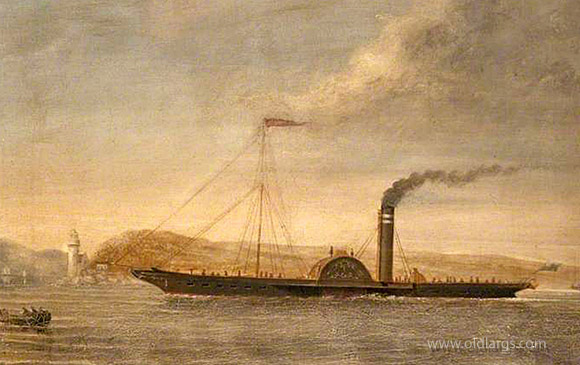
PS Mars
PS Petrel
Built 1845 by Barr & McNabTypical steamer of her day with two funnels aft of the paddle box. In 1855 had a big refit and her new owners put her on the Largs to Arran run. Was a frequent visitor to Largs until she was broken up in 1885.

PS Jupiter
Built 1856 by Tod and McGregor.Built for J Ried and D & A McKellar and was the first Clyde steamer to carry the name Jupiter. She was stationed at Largs and served the Glasgow, Largs and Millport route for 8 years. In 1862 she was bought by American civil war confederate agents as a blockage runner.
By 1860 the improvement in ship design and engine technology seen ships arriving on the Clyde which were powerful, reliable and very fast. After outbreak of the American Civil War (1861 - 65) the fast Clyde ships were targeted by the Confederates who had to find ships capable of running the 3,000 mile naval blockade imposed by President Abraham Lincoln in April 1861. His aim was to cut off Confederate supplies and stop their lucrative cotton exports. Over the next three years the Clyde steamer fleet was were decimated with their Scottish owners only to happy to accept the high prices being paid for their ships. Largs based Duncan McKellar's Clyde fleet was soon on the Confederates wish list with the Juno and then the Jupiter being sold for blockade running.
The confederate agents paid McKellar £6000. However once across the Atlantic the Jupiters blockage running career did not last long. During an attempt to break the blockage she was caught and captured off New Inlet, North Carolina,in 1863 by the USS Keystone State. This event was later painted by the american arist David Johnson Kennedy (1816-1898). The painting depicted the Jupiter after she was captured displaying her new American Union flag.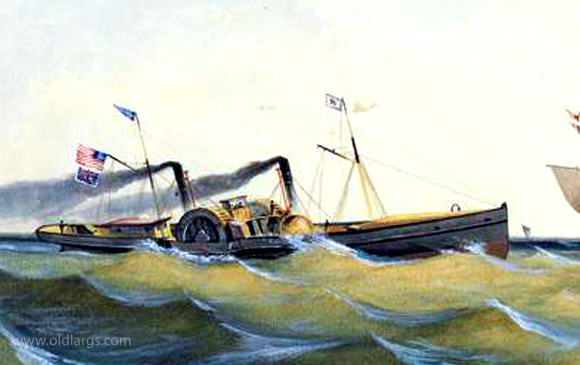
PS Jupiter
PS Juno
Built 1860 by Tod and McGregorRan by D & A McKellar on the Largs, Millport and Arran route. Said to be a good looking ship. In 1863 she was bought by American civil war confederate agents as a blockage runner. In July 1863 she arrived at Charleston from Nassau and ran the blockade. Later she requisitioned by the Confederate authorities and used as armed dispatch boat. The following year she began leaking off Charleston in heavy weather. She broke in two and despite jettisoning her cargo sank with the loss of 28 of the 30 on board.
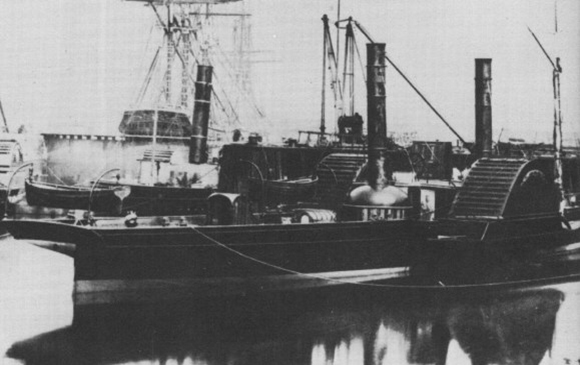
PS Juno
PS Meg Merrilies
Built 1866 by A & J Ingilis of PointhouseThe Meg hasd deck saloons fitted fore and aft and was said to be luxurious. She turned out to be very fast however was dogged with mechanical problems. She was sold on in 1868 and ended up in Constantinople. She was a regular visitor to Largs pier.
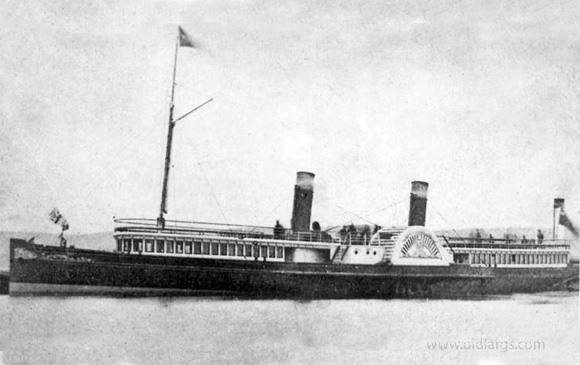
PS Juno
PS Craigrownie
Built 1870 by R Duncan & CoBuilt for the Gareloch station of the Greenock & Helensburgh steamboat Co. She started service and was based at Largs. Later sold on and operated routes from Glasgow to Lochgoil and Gareloch. Bought by London owners she moved to the Thames and was scrapped 1894.
PS Glen Rosa I
Built 1877 by Caird & CoThe Glen Rosa was built for Shearer Bros & Ritchie and was the first of two Clyde steamers to carry this name. She ran various services from Arran in steep competition with the Guinevere. Was eventually sold and ended up in the Bristol channel. After serving in WW1 she was scrapped in 1919.
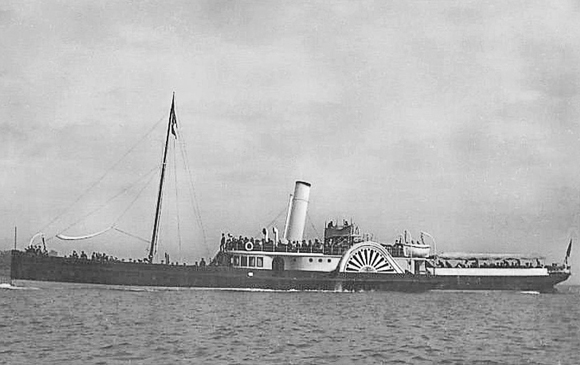
PS Glen Rosa I
PS Glen Rosa II
Built in 1893 by Thomson Ltd of Clydebank.Owned by Glasgow & South Western Railway, London Midland Scottish Railway and The Caledonian Steam Packet Co Ltd. Ran between 1893 and 1939. Glen Rosa had a capacity of 1035 and was used for excursion work and the winter runs for the Arran mail service. She later sailed on many routes including Largs, Ayr, Troon, Ardrossan, Wemyss Bay, Millport and Rothesay. She was the last survivor of the old Glasgow & South Western fleet and lasted until she was withdrawn from service in 1938. She was laid up in the Albert Harbour in Greenock and scrapped the following year.
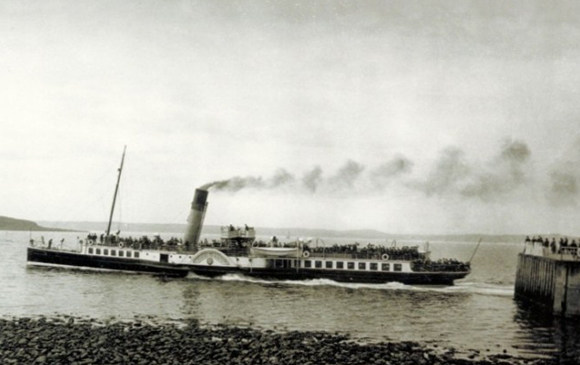
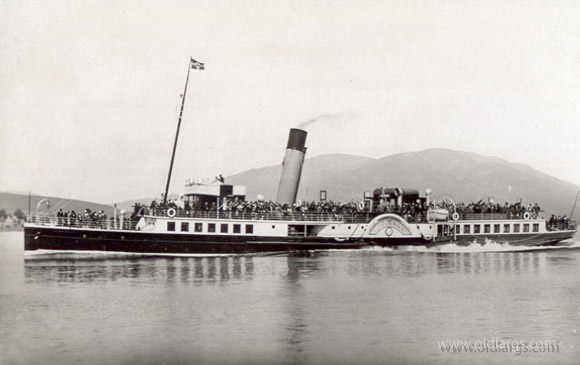
The Glen Rosa leaving Largs pier.
The Glen Rosa
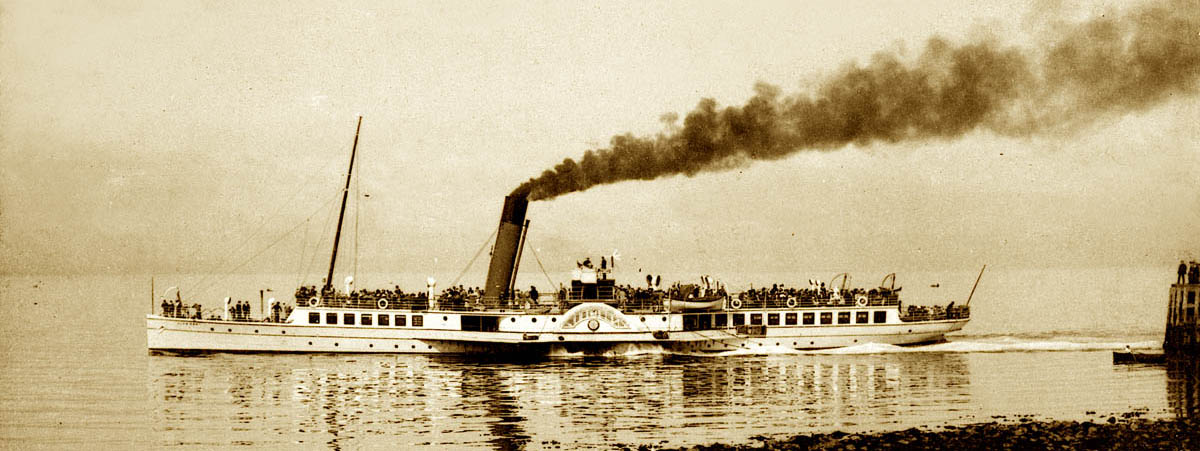
PS Jeanie Deans I
Built 1884 by Barclays Curle & CoThe name of Jeanie Deans was a well-known name along the Clyde for over 80 years. The first version was built for the North British co and turned out to be fast ,good looking and comfortably fitted out. The Jeanie Deans was an instant success on the Clyde which gave her a big advantage over other steamers. in 1894 she was upgraded to a full salon configuration increasing passenger comfort. In 1896 she was sold to an Irish owner but was back on the Clyde a few years later renamed as the Duchess of York. In 1904 she was sold again and renamed the Isle of Bute. Broken up in 1902. The name was later revived in 1931.
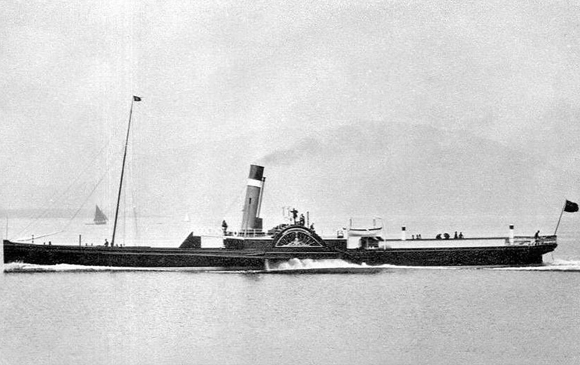

PS Jeanie Deans
PS Marchioness of Breadalbane
Built 1890 by J Reid & Co of Port GlasgowThe Marchioness was the first Caledonian Steam Packet Co ship and was put into service on the Gourock and Wemyss bay runs. She was requisitioned by the Admiralty as a minesweeper in 1914 and after the war returned to the Clyde. In 1935 was sold and cruised from Yarmouth on the East coast. After 40 years of service she was finally sold to a german shipbreakers in 1937.
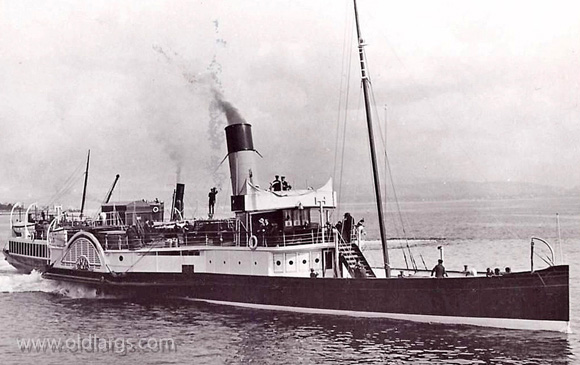
PS Marchioness of Bute
Built 1890 by J Reid & Co of Port GlasgowWas the sister ship of the Breadalbane and served on the same routes. In 1902 was bought and sent to the river Tay. Was also requisitioned by the Admiralty as a minesweeper in 1914 and survived until broken up in 1925.
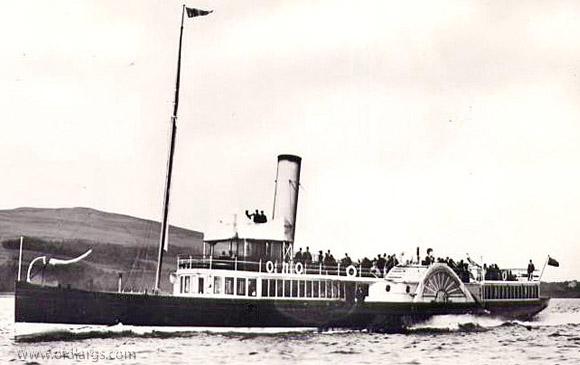
PS Marchioness of Bute.
PS Marchioness of Lorne
Built 1891 by Russell & Co, Port GlasgowOwned by the Caledonian Steam Packet Co. The Lorne was the first paddle steamer to use triple expansion engines however she fell short of her design speed which cost the engine builders a £100 fine. However she was well suited for the Arran runs during the winter months. In the summer she did the Wemyss bay to largs and Millport runs. After war duties in 1914 as a minesweeper she was in such a bad condition she was scrapped at Dumbarton in 1923.
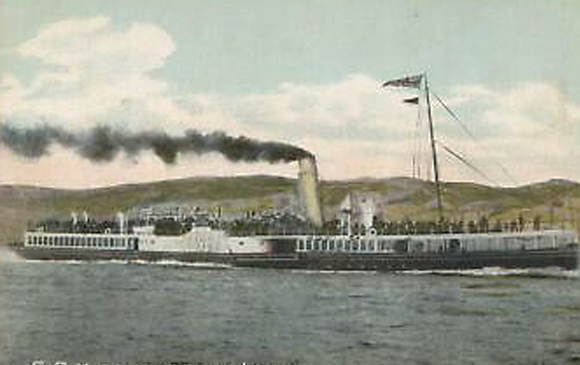
PS Marchioness of Lorne.
PS Glen Sannox II
Built 1892 by J & G Thomson of Clydebank.Owned by the Glasgow & South Western Railway Company. When the Sannox arrived on the Clyde after her sea trials under the G&SWR she was the fastest ship on the Clyde at 20 knots. By arranging timetables to provide suitable connections with trains from Glasgow to Winton pier it was possible to travel from Glasgow to Brodick in 88 minutes. The Arran run was the route she was designed for and most of her service was on this run. As a popular ship she was in demand for special cruises and charter, often bringing her to Largs. The very sight of her by other ships represented a challenge , and it was not unknown for racing to take place. She was broken up in 1925 however the name Glen Sannox would be linked with the Clyde up to the present day with three more ships taking up the name in 1925, 1957 and the latest in 2017.
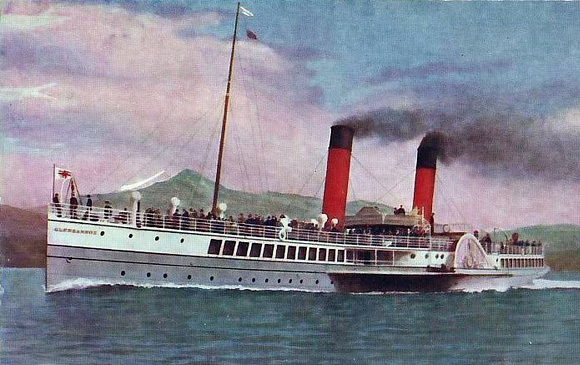
PS Glen Sannox II
PS Waverley
Built 1899 by A & J Inglis of PointhousesOwned by the British Steam Packet Co. She was the third ship to take on the name of the Waverley and was designed for Clyde cruises. She started with excursions around Bute and for the next fourteen years was a regular visitor to Largs. In 1914 she began service as a minesweeper. Modifications made to her during the war were retained where the most obvious change being the repositioning of her bridge from its original location between her paddle boxes to a new location in front of her funnel She continued to sail the Clyde excursion routes until being replaced as the fleet’s flagship by the newer PS Jeanie Deans in 1931 and was retired in 1939
With the start of World War II The Waverley was used to evacuate children from Glasgow to various locations on the Clyde coast. She was then used by the navy as a minesweeper on the East coast of England. On the 28th May 1940 she was sent to help evacuate allied troops from Dunkirk. The next day she was attacked by 12 German Heinkel aircraft while on her way back to England. She managed to shoot two planes down, but was finally hit by 3 bombs and started to sink fast. In total 350 officers and men went down with her. This happened on the 41st anniversary of her own launch date.When the Waverley was being refitted for her World War 2 service, the Admiralty had wanted to remove all the teak passenger seats from the deck. they did not believe the seats had any use on a minesweeper. However her captain was insistent that the seats remained because they were designed as life-rafts with buoyancy tanks fitted to their underside. He later credited these life rafts with saving lives including his own, while the crew and troops waited to be picked up after the ship sank. After over two hours in the water, 158 were picked up by the French destroyer Cyclone and 285 by the HMS Golden Eagle, with a handful picked up by smaller vessels.
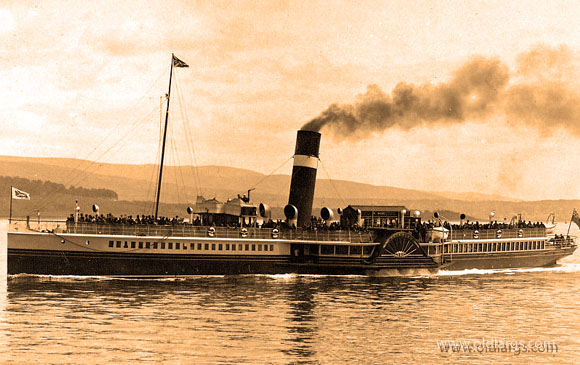
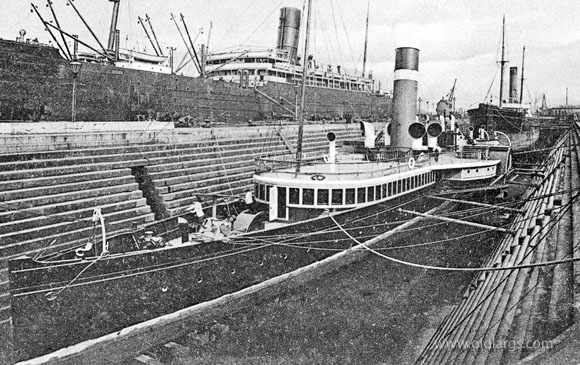
The 1899 Waverley
The Waverley in dry dock
